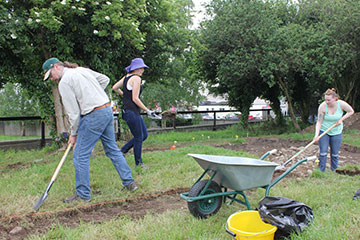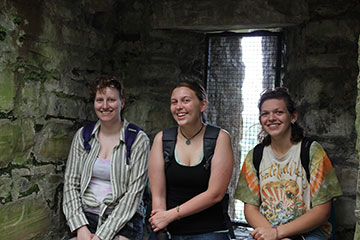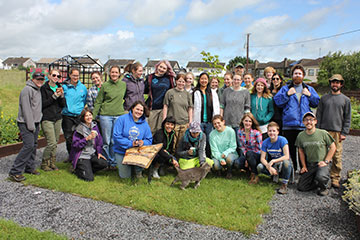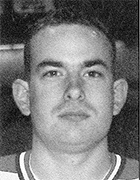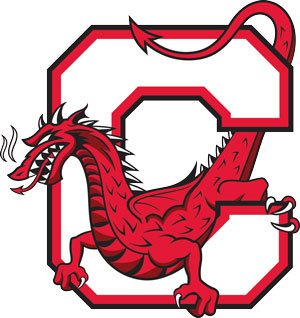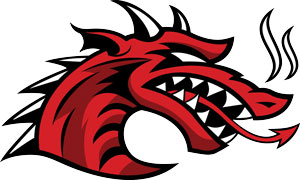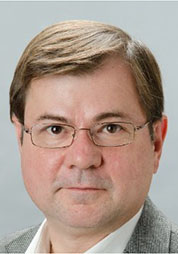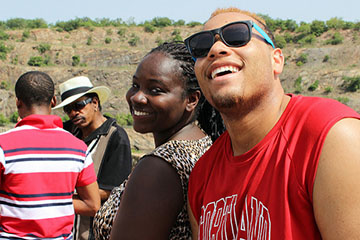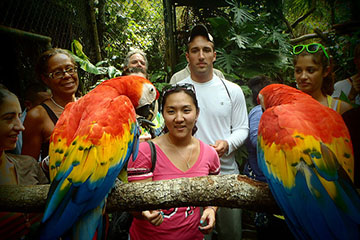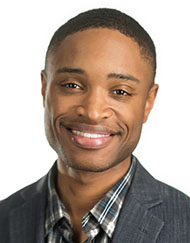
|
|
Issue Number 1 • Tuesday, Aug. 30, 2016 |
Campus ChampionMary Kate Boland’s involvement with SUNY Cortland didn’t end when she spoke at Commencement 2006 as president of the Student Government Association. The former biology major now advises SGA and offers guidance, advice and training to student groups as assistant director of Campus Activities. Currently in the midst of Welcome Week — with its busy days, evenings and weekends — Mary Kate is thrilled to be living just around the corner. She recently became the first College employee to benefit from the Live-In-Cortland Committee’s homeowner program. When did she move into her new house? Move-in weekend, of course! Wednesday, Aug. 31Student Employment and Volunteer Fair: Sponsored by Career Services, Corey Union Function Room, 3-5 p.m. Wellness Wednesday: Sampler of Health Self-Care Techniques: Corey Union Function Room, 7 p.m. Thursday, Sept. 1Dowd Gallery Opening Reception: “Fade to Gray” by Jaime Brett Treadwell ’99, Dowd Fine Arts Center Exhibition Gallery, 4:30-6 p.m. Friday, Sept. 2Red Dragon Pride Day: Ice Cream Social at 1 p.m., Pride Day photo at 1:40 p.m., Corey Union steps New Transfer Welcome BBQ: Bishop and Shea Halls quad, 4 p.m. Outdoor Pursuits Meet and Greet: Outdoor Pursuits Center, Student Life Center, 6 p.m. Cortland Nites Mini Golf: Shipwreck Golf. Free tickets available at Corey Union Information Desk from 7-8 p.m. Buses depart at 8, 9 and 10 p.m. Saturday, Sept. 3Dayhike at Fillmore Glen State Park: Meet at Outdoor Pursuits Center, 9 a.m. and 1 p.m. Sunday, Sept. 4Dayhike at Fillmore Glen State Park: Meet at Outdoor Pursuits Center, 9 a.m. and 1 p.m. Great New York State Fair Bus Trip: Buses depart from Corey Union, 5 p.m. Monday, Sept. 5Labor Day: No classes in session Student Activities Board Carnival and Student Club Fair: Corey Union steps, noon Tuesday, Sept. 6Lecture: “Does Immigration Increase the Quality of Democracy? A Study of Migrants in Europe,” by Gabriel Badescu, a faculty member at Babes-Bolyai University in Cluj-Napoca, Romania, who also directs the institution’s Center for Democratic Studies. Sperry Center, Room 104, 4:30 p.m. Artist’s Talk: Jaime Brett Treadwell ’99, will discuss his new paintings in “Fade to Gray” exhibit, Dowd Fine Arts Center Exhibition Gallery, 5-6 p.m. Open Mic Night: Corey Union Exhibition Lounge, 7 p.m. Disney College Program Information Session: Van Hoesen Hall, Room B-5, 7 p.m. Wednesday, Sept. 7Wellness Wednesday: “Major Key Alert! Your Vote Matters,” Health Promotion interns will lead a voter registration and share information about the candidates, Student Life Center lobby, noon-3 p.m. Comedian Aarona Lopez: Presented by the Student Activities Board, Corey Union Function Room, 8 p.m. Friday, Sept. 9Training: S.H.A.P.E. (Sexual Health and Assault Prevention Educators) training for those who want to be a part of the effort to help prevent sexual assault. All students, faculty, and staff welcome. RSVP “yes” to [email protected], Brockway Hall Jacobus Lounge, 3-9 p.m. UUP Annual Fall Welcome Picnic: United University Professions Cortland Chapter, Recognizing Chapter Activists, Yaman Park, Pavilions I and II, 4-7 p.m. Friday, Sept. 10Employee Fall Festival: For employees and their immediate family members, Park Center Ice Arena, 10:30 a.m.-2 p.m. RSVP by Thursday, Sept. 1. Monday, Sept. 12Lecture: “Rising Role of Asia in the World Economy,” by Luis Enrique Breuer Mojoli, a representative of the International Monetary Fund. He will discuss the agency’s recent work in Asia, Moffett Center, Room 2127, 4:30 p.m. |
Students Return From Educational Adventure08/30/2016When SUNY Cortland students return to campus after summer break, some travel a lot farther than others. Senior world archaeology major Jordi Naczi, for example, journeyed back to Central New York from Ireland. Medieval, 13th-century Ireland to be exact. Naczi, a Marcellus, N.Y., native, was one of two SUNY Cortland students who spent four weeks working and learning amid the archeological ruins of a Catholic friary in Trim, Ireland. The course, taught by archaeologist Scott Stull, a SUNY Cortland adjunct professor of sociology and anthropology, was offered in conjunction with the Irish Archeological Field School. It was one of many summer programs that allowed SUNY Cortland students to experience similar educational adventures in India, Greece, Turkey, Australia, Costa Rica, Belize, Germany and other countries. “There’s’ something really amazing about getting in there and finding something that’s hundreds of years old,” said Naczi, who learned how to pull meaning from the time-worn rubble of Ireland’s Black Friary. “Like, ‘Wow, this is something that was lost to history and now it’s found.’” The friars who painstakingly transcribed religious texts in the 13th century religious community likely would have appreciated the attention to detail practiced by Naczi, Stull and Caroline Sampson, a SUNY Cortland archeology major from Delmar, N.Y. From June 4 to July 2, Stull’s group engaged in excavation and archeological field work training in the rural County Meath community situated on the River Boyne. They applied both traditional and cutting-edge technology to make educated guesses about how members of the ancient religious order lived their lives. “This field school is where you go from whatever theoretical knowledge you have of archaeology and put it into practical use,” Stull noted. “You get the experience that you can’t get sitting in a classroom or even in a laboratory. This is the ‘learning how to be an archeologist’ class on an archeological site.” Trim is perhaps best well known for medieval structures that are still standing, including Trim Castle, the largest Cambro-Norman castle in Ireland, and its St. Patrick’s Cathedral.
Naczi and Sampson can now boast they’ve worked on an original, professional archeological dig. Quarried as a source of building material for hundreds of years after it ceased as a monastery, the Black Friary site retains only subtle clues for researchers to ponder. “I didn’t find pieces of pottery or coins, but I excavated an area where there was possible metaling, which means there could possibly have been a floor and door area there,” Naczi said. “‘Metaling’ is just a fancy word for a ‘place of compacted small stones.’” Stull’s specialty is “access analysis.” He has studied how people with different social standing were allowed access in and around medieval German castles as well as President Lincoln’s Cottage and other early American historic buildings. He has a Certificate in Museum Studies from Harvard University. At Trim, medieval structures haven’t been erased by development compared to their counterparts in places like Great Britain. So the placement of churches, monasteries, castles and other medieval structures and their proximity to one another is more easily studied. For his own research, Stull gained insight from comparing the “conquest” process of castle building found in Ireland and Great Britain — which was heavily invaded by the Normans — to the “non-conquest” castles found in Germany. “I’ve been working on a project on the placement of castles on a landscape,” Stull said. “There is a section of medieval agricultural fields that were associated with the castle and adjacent monastic site that are still there. It’s as it was, except for a couple of roads and some things that have fallen into ruin. The village itself still has the medieval layout and so here I can go and see a castle in a remarkably well-preserved landscape. And I came to understand the process of conquest through castle building: because I had spent enough time there, I could see all of the connections.” On one day in particular, Stull and Naczi set aside the painstaking digging that typifies an archeologist’s occupation. At the Yellow Steeple, part of another monastic ruin, Naczi monitored a sophisticated digital camera mounted on a wheeled tripod as it created a multitude of exact, 3-D scanned images inside the building. Supplied by Ithaca College, the equipment is designed to capture both the look of the surroundings and its exact location.
Although she appreciated the experience, “I definitely prefer the hands-on digging in the ground,” she said. “The scanning does all the work for you. It goes around and you just kind of sit there and make sure it’s working.” “I like the field work,” she said. “I like getting dirty.” Stull explained that the building scanning project continues his ongoing partnership with Michael “Bodhi” Rogers, an archeogeophysicist and an Ithaca College associate professor in the Department of Physics and Astronomy. The co-investigators began collaborating about a decade ago when Stull was an anthropologist working for a private company, Hartgen Archeological Associates in Rensselaer, N.Y. Rogers has a doctorate in physics and a master of science in archeology while Stull brings anthropology and social science to the mix. Besides preservation, the ultimate goal of using the 3-D scanning equipment shared by Rogers is to let historians and enthusiasts take an electronic stroll through historic ruins without leaving their armchair. Stull, who joined SUNY Cortland’s Sociology/Anthropology Department in 2011, noted the equipment is a step up from a panoramic photo, because the viewer can look at the digital visual model of the site from any angle, without any distortions. The original goal and the primary use for this is as a preservation tool, Stull said. It’s going to be imported into an architectural drawing program from which scholars can then select points and link information to it. “I liked the fieldwork but I also liked the teaching,” Naczi said. “I think in high school there’s not enough on the fields of archeology or even anthropology. So I feel like kids don’t get exposed to it enough to know what that is.” Studying in another country has opened her eyes to a new world.
“It has a pretty significant impact, I feel, on how people think about the world and how people think about other cultures,” said Naczi. While working in Trim stayed in the home of an Irish family. “We don’t really get that exposure of different cultures. So you have all these kids going off to College who are very ethnocentric.” Stull agreed the field school offered a remarkable study abroad opportunity. “There’s a different level of understanding that you get from going to the site, going to another country and actually learning what all these little pieces that we pick up from our classes and from popular culture: what it means to be Irish and be in Ireland and have the experience of being there,” Stull said. “Sometimes there are things that you learn because you are on a historical site that you wouldn’t think to put together if you are not there,” Stull said. Cortland Athlete-Turned-Artist Exhibits at Dowd Gallery08/26/2016Jaime Brett Treadwell ’99 didn’t score many goals as a captain of the Red Dragon hockey team 17 years ago, but created a lasting SUNY Cortland hockey legacy. “There’s still a sculpture of a hockey player that I made in the Park Center on the second floor outside the rink,” said Treadwell, now a professional artist with an exhibit at SUNY Cortland’s Dowd Gallery. “It’s probably my most literal translation of hockey to art.”
Treadwell’s recent collection of brightly colored abstract paintings, titled “Fade to Gray,” opened Aug. 29 and will run through Friday, Oct. 7. His return to campus will include an artist’s talk, a printmaking demonstration and the creation of a hallway mural in Dowd that he will produce with SUNY Cortland students. “Jaime was a decorated hockey player while he was at SUNY Cortland,” said Dowd Gallery Director Erika Fowler-Decatur, talking about the artist’s deep connection to the College. “He was one of our relatively rare artist-athlete students.” The artist admits he chose Cortland primarily for its varsity ice hockey team. “I wasn’t much of a goal scorer,” Treadwell acknowledged. “I was a stay-at-home defense man, someone who doesn’t let the other team score. “I look back and wonder how I was able to balance two completely opposite worlds.” He captained the team his senior year and also bolstered his teammates’ overall academic profile by reliably earning a strong grade point average in art and in his other interests, communication studies and the humanities. Treadwell graduated with honors in 1999 with a BFA in painting and sculpture while capturing coveted art scholarships. These included a Gerald N. DiGiusto Scholarship and SUNY Cortland’s Excellence in Studio Art Scholarship.
Treadwell had wielded a hockey stick from age 12, but said he embraced art much earlier. When other children had lemonade stands on their parents’ front lawns, he sold pastels at his ‘art stand’. Treadwell first pursued sculpture at SUNY Cortland under Allen Mooney, professor of art and art history, now emeritus. He then took a painting course from the noted portrait artist George Dugan. “He took me under his wing, urged me to go on to graduate school,” Treadwell said of the late SUNY Cortland professor emeritus of art and art history. “After college, with his encouragement, I and three of my classmates rented a warehouse off Tompkins Street, installed a shower and left the bubble of SUNY Cortland to go out into the community as artists. Three of us went on to graduate school.” Treadwell earned an M.F.A. in painting from the University of Pennsylvania. Both Treadwell and his mentor, Dugan, shared a long collaboration, although over the years their artistic styles diverged as Treadwell explored new and more contemporary themes. They once co-taught Dugan’s annual painting course in Dingle, Ireland. Dugan passed away earlier this year. Treadwell, who lives and works in Philadelphia, teaches as an associate professor of art at Delaware County Community College, where he was presented with the institution’s 2015 Gould Award for Teaching Excellence. He has earned numerous grants, fellowships and art awards. His work has been displayed in six solo exhibitions and in 36 select group exhibitions at American galleries and at one in South Korea.
His more recent artwork features invented geometrical forms in vivid, synthetic colors that seem to shimmer and shift under their highly varnished surfaces. His style combines the retro-aesthetics of science-fiction, futurism and digital graphics, which evoke a kind of 1980s nostalgia. The “Fade to Gray” exhibition will be open to the public from 10 a.m. to 4 p.m. Monday through Friday and by appointment. The events and programs are free. They include:
One of Treadwell’s former instructors is Kathryn Kramer, department chair and professor of art history at SUNY Cortland. “These new works exist squarely within the current revival of Op (Optical) Art, a style emerging in the 1960s and comprising abstract, geometric patterns and shapes that often feature optical illusions,” Kramer noted. Treadwell describes this recent body of work as “venturing into a new direction for me, focusing solely on the basic elements of color, line, shape and light. It also attempts to challenge perceptual certainty through the contrast of blurred and focused imagery.” A common thread through his creative phases has been his unabashed neon-bright palette. “Color is the main thing of all my work,” Treadwell said. “The hues and values all have to be right. I’ll stare at the painting forever. It’s like you’re at the restaurant and can’t decide on two different choices. But the color is very deliberate.” His work has undergone several phases and some of his less recent, but perhaps more familiar, paintings mash up classical figures with American pop culture: Grecian statuary mingling with bikini-clad manikins against a campy, yet riveting, neon background. “If I can make something corny also be beautiful I’m totally satisfied,” Treadwell said. He has a website that includes information and examples of his work, snapshots of him at work in his studio, and a selection of magazines that featured his cover art and contain interviews with him inside. A recent interview by Tim Maclean in Wow magazine attempts to explain his work. The Dowd Gallery is located in SUNY Cortland’s Dowd Fine Arts Center at the corner of Graham Avenue and Prospect Terrace. For group tours, contact Fowler-Decatur at 607-753-4216 or [email protected]. Capture the MomentMallory Nunez, a sophomore from Wappingers Falls, N.Y., says goodbye to her mom, Miriam Real, during Move-in Day on Aug. 26. Nearly 7,000 students began classes at SUNY Cortland on Monday, the first day of the fall semester. In Other NewsAthletics Logo Gets a Makeover
You may have noticed that the Red Dragon logos on some of the apparel at the campus store looks a bit different these days – stronger, sharper, more ferocious. You might have thought the same thing about the dragon in the new logo on the floor of Corey Gymnasium in Park Center, or the one in the center of the recently upgraded White Field at the SUNY Cortland Stadium Complex. What you’re witnessing is evolution. Blaze, the College’s fire-breathing, reptilian mascot, recently received his first official makeover since SUNY Cortland adopted “Red Dragons” as the institution’s athletic nickname in the early 1930s. The new primary and secondary athletics logos represent an effort to blend SUNY Cortland’s proud traditions with an updated look conveying the determination, grit and competitive spirit exhibited by our students in athletics, academics and improving the world around them. “These new images provide a unique identity that reinforces the unrivaled success of our student-athletes and our institution as a whole,” said Mike Urtz ’94, the College’s director of athletics. “We set out to keep our primary logo largely intact as a way of preserving our storied past. At the same time, we sought a bold look that represents excitement for the future, and we achieved it with the new secondary mark. This was a win on many levels.” The College’s primary logo received very minor adjustments to make it more attractive, easier to reproduce and more consistent in appearance both on and off campus. A new secondary mark, which features a close-up of the red dragon’s head, will not replace the primary logo. Instead, it offers a new look for the College’s athletics teams to wear on the field and a new way for students, alumni and fans to display their Red Dragon pride. Graph-Tex, a Cortland-based company that specializes in graphic design and custom screen printing, created the logos. SUNY Cortland also has published a new style guide specific to the acceptable use of its athletics identity. “We’ve received a lot of positive feedback from student-athletes, coaches, alumni and campus community members,” said Jaclyn Lawrence ’12, the College’s assistant director of athletics for events, marketing and development. “It’s important for one of the strongest Division III athletics programs to have an attractive and consistent visual image.” Founded in 1868 as Cortland Normal School, SUNY Cortland changed its nickname from the Normals to the Red Dragons in 1933. Since then, the College has earned 25 national team titles in 10 sports, 102 individual national crowns and more than 200 conference championships. SUNY Cortland boasts one of only five Division III programs nationally — out of approximately 450 — to place in the top 25 of every NCAA Directors’ Cup standings for overall athletic excellence. IMF Official to Predict Asian Growth TrendsA visiting international development official will discuss the meteoric rise of Asian economies and their future growth or stagnation on Monday, Sept. 12, at SUNY Cortland. Luis Enrique Breuer Mojoli, a representative of the International Monetary Fund (IMF), will discuss the agency’s recent work in Asia, at 4:30 p.m. in Moffett Center, Room 2127. Breuer Mojoli serves as division chief of the IMF’s Asia and Pacific Department, will present “Rising Role of Asia in the World Economy.”
Organized by the International Studies Program and the Clark Center for International Education, the event is free and open to the public. “Asian economies are sailing in choppy waters, facing headwinds from an uncertain and challenging global environment,” Breuer Mojoli said. “But the region also has many strong points in its favor. The rise of China as a global economic superpower has also created challenges of its own and its global growth over the medium term remains bumpy.” In his lecture, Breuer Mojoli will explore what challenges and opportunities exist for Southeast and East Asian countries from the Trans-Pacific Partnership and China’s economic growth. He’ll share his forecast for the fastest-growing large economy in the world, India. As a division chief for the IMF since 2012, Breuer Mojoli pursues economic policies for development and stability in Indonesia, Bangladesh, Sri Lanka and Maldives. He is co-responsible for analytical work on Southeast Asian countries. Currently he also coordinates the work on emerging ASEAN countries including Indonesia, Malaysia, Philippines, Singapore and Thailand. Mojoli, a native of Paraguay who lives in Washington, D.C., also has worked in Peru, Belize, Colombia, Korea, Myanmar, Solomon Islands and Thailand. Breuer Mojoli has led negotiating missions to Honduras, Nicaragua and Jamaica. He has served the IMF as senior representative in Peru and Bolivia. His scholarship has been published in journals on economic growth, political economy of economic reforms, stabilization policies and monetary issues. Breuer Mojoli earned a B.A. in economics and political science from University of the Pacific in Stockton, Calif. He received M.S. and doctoral degrees in economics from the University of Illinois at Urbana-Champaign. This event is supported by the Asia-Middle Eastern Studies Committee, Political Science Department, and a Campus Artist and Lecture Series (CALS) grant. For more information, contact Alexandru Balas, assistant professor of international studies, coordinator of the International Studies Program and director of the Clark Center for International Education, at 607-753-4823 or [email protected]. Romanian Scholar to Analyze European MigrationA Romanian professor of political science will explore a currently hot topic on whether the process of developing democratic citizens through migration has worked well in Europe on Tuesday, Sept. 6, at SUNY Cortland. Gabriel Badescu, a faculty member at Babes-Bolyai University (UBB) in Cluj-Napoca, Romania, who also directs the institution’s Center for Democratic Studies, will discuss “Does Immigration Increase the Quality of Democracy? A Study of Migrants in Europe” at 4:30 p.m. in Sperry Center, Room 104. Organized by the International Studies Program and the Clark Center for International Education, the talk is free and open to the public. Badescu will bring a uniquely European perspective on a subject of research that governments around the world would be eager to find out. The future of many European political systems, leadership and their open or closed-door policies toward immigration could hinge on what decisions are made on this matter. Badescu’s lecture will examine the relationships between cultural diversity and political culture. Using survey data collected from Romanian migrants in Italy and Spain as well as survey data on Romanians who returned to their home country, the study evaluates predictors of pro-democratic attitudes among this population. Badescu’s main fields of specialization are comparative politics, quantitative/qualitative methods and research design. He has studied such areas as democratic and economic transitions in Eastern Europe, labor migration, youth socialization, civil society, social capital, political and social participation in comparative perspective and value change. He has held a Fulbright post-doctoral research fellowship at University of Maryland, College Park. Badescu was presented with an international fellowship from the Open Society Institute. He has received many awards for his scholarship. He is the author or co-author of many books related to his scholarship, including Social Capital and Public Participation (Bucuresti: Tritonic Press, 2013). Between 2009 and 2010, Badescu coordinated the Romanian Agency for Governmental Strategies. He also chaired UBB’s Political Science Department from 2003 to 2015. Since 2005, he has directed the Center for the Study of Democracy. Badescu earned a B.S. in mathematics, a B.A. in sociology and a doctorate in sociology at UBB. This event is supported by the Project on Eastern and Central Europe (PECE) and the Political Science Department. For more information, contact Alexandru Balas, assistant professor of international studies, coordinator of the International Studies Program and director of the Clark Center for International Education, at 607-753-4823 or [email protected].
Study Abroad Fair Set for Sept. 14SUNY Cortland’s international school partners including Belize, Costa Rica, France, Mexico, Spain and the United Kingdom will showcase their programs during a Study Abroad Fair on Wednesday, Sept. 14. The event will be held from 11 a.m. to 2 p.m. in the Corey Union Main Lobby. The fair is free and open to the campus community. Information on funding and scholarships will be available. “Students who visit the Study Abroad Fair will learn of the more than 900 options in the SUNY system where they can study abroad in winter, spring, summer or fall,” said Hugh Anderson, a study abroad advisor in the College’s International Programs Office, which is hosting the fair.
“There is a program for every field of study — some for the same cost as studying here at SUNY Cortland or even less,” he said. At the fair, students who have studied abroad already, as well as international visitors on campus and representatives from other SUNY campuses, will be on hand to describe their life-changing experiences and give their classmates a taste of what awaits them as scholars in a different land. Participants may enter a raffle for a chance to win one of two $500 travel awards that can be used in the future towards any SUNY study abroad program. At SUNY Cortland, students may choose from a wide array of SUNY-sponsored destinations, virtually anywhere in the world, in a range of disciplines. Study abroad participants may choose options that include attending a college or university, participating in an internship, student teaching, volunteering their talents, engaging in a faculty-led program or joining a short-term specialized program.
“Study Abroad 101,” an information session on how to get started with the study abroad process, will be offered throughout the semester. Individuals only need to attend one session. These will be offered every Tuesday at 4:30 p.m. and every Friday at 3 p.m. in Old Main Colloquium. Surveys exploring the long-term impact on a student’s personal, professional and academic life show that the experience of immersing one’s self in another culture positively influences the individual’s career paths, world-view and self-confidence. For more information on the fair, contact [email protected] or 607-753-2209 or visit the International Programs Office in Old Main, Room 219 or online at cortland.edu/studyabroad. College Offers Fall ‘Wellness’ Series for Campus, CommunityIn keeping with a College priority of well-being, each semester SUNY Cortland offers weekly encouragement to the campus and community to pursue a lifetime of good health. The Fall 2016 “Wellness Wednesday Series” will feature events intended to motivate campus and community members to learn more about health and wellness. Programs continue through the fall semester with topics including yoga and other self-help techniques; using social media to improve one’s future professional reputation; a discussion with a panel of LGBTQ allies; understanding the stages of drinking alcohol; and a panel on biomedical science careers. Primarily sponsored by the Health Promotion Office and the Student Development Center, the series will take place on Wednesdays at 7 p.m. in Corey Union Exhibition Lounge, unless otherwise noted. The events are free and open to the public.
For more information or accommodation to attend an event, contact Lauren Herman, the College’s health educator, in Van Hoesen Hall, Room B-1, or at [email protected] or 607-753-2066. Summer Research Fellows Seize Opportunity Outside ClassroomFor much of the summer, SUNY Cortland senior Allison Schumann spent her afternoons paying close attention to computer screens in an exercise physiology research lab at the College. They revealed crucial real-time data on the oxygen consumption of the runner she was testing on a nearby treadmill. Schumann, an exercise science major with aspirations to pursue physical therapy, would request temperature readings from fellow students assisting her. She’d also give orders to Jim Hokanson, a professor of kinesiology who served as the faculty mentor for her summer work. “Where else will you hear students telling their professors what to do?” Hokanson said. It’s a given that SUNY Cortland’s undergraduate researchers take ownership of their projects. They’re leaders and doers, not merely passive observers who are content watching from the sidelines. Unquestionably, their faculty mentors offer crucial advice and assistance. But for the most part, the student researchers rely on their own self-motivation. Eleven students were presented 2016 undergraduate research summer fellowship awards, which provide a $2,750 stipend and eight weeks of campus housing if needed. Project topics represented a range of different academic majors and topics — from psychological resilience to stem cell research to an examination of the wage gap between genders. All of them will be on display next spring semester at Transformations, the College’s celebration of student research and creative work. Students conduct original research in their discipline through the summer fellowship program, acquiring and creating knowledge beyond what can be achieved in the classroom. “This year’s summer fellowship competition was the most competitive we’ve seen since the inception of the program in 2006,” said Christopher McRoberts, the director of SUNY Cortland’s undergraduate research program and distinguished professor of geology. “It has allowed us to fund some really interesting projects with real-world applications.” Schumann served as the conductor of a project testing a runner’s efficiency on the College’s Alter G treadmill, a valuable piece of equipment that can decrease body weight below the waist and aid rehabilitation from lower body injuries, chronic pain or neurological conditions. It’s an incredibly valuable tool for research related to physical therapy. “Working with the Alter G gave me even more experience with important rehab equipment,” said Schumann, who also competes on SUNY Cortland’s cross country and track and field teams. Fortunately, she did not detect a significant change in run economy — essentially a runner’s efficiency — at 85 percent of a person’s actual body weight. But she did notice changes after lowering gravity to 60 percent of a runner’s weight. That’s enough to inspire future research on exactly when the change occurs. “This is the type of hands-on experience that’s going to help Allison as a physical therapist,” Hokanson said. “She saw firsthand that she can lower someone down to 85 percent (of their body weight) and their run economy won’t change.” Quintin Casella, a senior conservation biology major, and Angela Pagano, an associate professor of biology, developed a similar bond through field research more than a year ago, working together on a project that could benefit one of SUNY Cortland’s most precious resources: the William H. Parks Family Center for Environmental and Outdoor Education at Raquette Lake. They’re building on work Pagano started in graduate school, which seeks to better understand the link between aquatic plant communities and lake health. Part of it means learning to manage variable-leaf milfoil, an invasive lake species that threatens native species and negatively impacts recreational activities such as swimming and boating. Herbicides can be effective as treatment but they poison the lake. A plastic tarp also could work, but it’s dangerous to lay down and harmful to the lake as well. That’s what led the research team to try different types of biodegradable jute matting as a viable way to shade out the aquatic plant on the lake floor surface. They hope to determine the best type of pattern to control the invasive species and also preserve the environment longterm. “I’m a conservation biology major, so this is totally what I’m into: being out in the field, doing research, in the Adirondacks of all places,” said Casella, who earned the inaugural David F. Berger Summer Research Fellowship for the top overall student proposal. “You’re working with a relevant issue and doing work that could potentially change how people manage resources, so it’s very exciting.” Pagano said Casella’s field research talents came naturally. The project meant suiting up in diving gear, working in tandem off a boat. “I remember coming up from the water and needing something, and then there being a hand giving it to me before I even said what I needed,” Pagano said. “Being able to anticipate needs and being able to work independently are two areas where Quintin really excels.” They built an even larger collaborative research network with Kenneth Hawks, the president of the Raquette Lake Preservation Foundation, and colleagues from Lebanon Valley College in Annville, Pa. Hawks provided boat access, additional funding support and local expertise setting up and preserving long-term monitoring sites. “The College has this really great field station, and here we’ve built this little research community to better understand the lake system as a whole,” Pagano said. “It’s been great in so many different ways.” For Caitlin Rasefske, a senior exercise science major, summer research meant venturing outside of her major to conduct meaningful research. Her work as a resident assistant introduced her to Jena Nicols Curtis, an associate professor of health who each semester trains countless SUNY Cortland students on safe sex habits. The pair has set out on a pioneering project to analyze different institutional policies related to emergency contraception (EC), or safe means of birth control such as the Plan B pill. Rasefske pointed out that nearly 80 percent of pregnancies in 18- and 19-year-olds are unintended, so they’re also working to determine when students are most likely to request EC from their college’s health services office. “I’m always excited when students ask questions that I can’t answer,” Curtis said. An aspiring nurse, Rasefske said she wanted to explore a “hot topic” in the healthcare field. “Dr. Curtis and I both had similar questions and ideas, and so we just ran with them,” Rasefske said. “If there’s anything we can do to prevent an unplanned pregnancy, we absolutely want to do it.” That started with Rasefske spending a week on campus in mid-July to analyze policies and data from four campuses, compile graphs and note trends. There’s still more work to do, but she and Curtis have observed that students tend to request EC more at the beginning and end of each week. “What we’re doing is especially interesting because no one has done this before,” Rasefske said. “We’re doing something brand new and it’s incredibly exciting.” 2016 Undergraduate Research Summer FellowsSelect a student’s name below to read more about his or her summer research project. Stefania Buta, psychology
Faculty mentor: Leslie Eaton, psychology Project title: “Profiles of psychological resilience: Electroencephalography of fixation, emotional challenge and recovery” In her own words: “My research program focuses on intra-individual resilience. Using specific patterns of electroencephalography (EEG) and electrodermal activity (EDA), our study measures psychological qualities of emotion, attention and homeostatic regulation. I am examining the time course of emotional responding to negatively-loaded images with an emphasis on the fixation points that appear to the participant just before the picture. Right now, using the EEGLAB module of MatLab, Dr. Eaton and I are quantifying features of neural activity during the presentation of the fixation points, photographs, and during inter-trial periods. The hypothesis is that the fixation point itself will become a conditioned emotional elicitor once the first negative emotion picture has been presented. These data might lead to some important clues about how resilient people regulate their physiological responses to negative life events. We hope that this research leads to improved interventions for individuals diagnosed with PTSD and mood-related psychological disorders.” Quintin Casella, conservation biology
Faculty mentor: Angela Pagano, biological sciences Project title: “Examination of biodegradable jute matting as a management option for the invasive aquatic plant, variable-leaf milfoil (Myriophyllum heterophyllum)” In his own words: “(Variable-leaf milfoil) ends up affecting the lake system as a whole because it changes how plants and organisms interact. So we’re working with an invasive species management technique with different grades of jute matting, where you shade out the aquatic plant on the surface of the lake floor. And we’re doing it in a new way because we’re using biodegradable material.” Anna Gorall, international studies and archaeology
Faculty mentor: Sharon Steadman, sociology/anthropology Project title: “Çadir Höyük: Stability or change in the shadow of a failing empire?” In her own words: “I’ve been conducting research at the archaeological site of Çadir Höyük in Central Turkey. My research goal is to investigate the impact the fall of the Hittite Empire had on the villages surrounding it through ceramic analysis. Changes in the style of pottery found at the site at different time periods will give me insight on how the people of Çadir Höyük handled the collapse.” Joseph Hannett, biomedical science
Faculty mentor: Theresa Curtis, biological sciences Project title: “Neuroprotective effect of stem cells” In his own words: “I use stem cell secretions to protect neurons from oxidative stress … I’ve always been intrigued by neurons, and the effects neurodegenerative diseases have on the body. Conducting full-time research has provided me with an opportunity to further my understanding of this topic and become a more knowledgeable biologist.” Adam Hocking, conservation biology
Faculty mentor: Timothy Baroni, biological sciences Project title: “Bryophytes of Hoxie Gorge: Ecology, diversity, online field guide” In his own words: “The purpose is to identify the biodiversity of bryophytes present at Hoxie Gorge and to gain a greater understanding of the property. Identifying the bryophytes is essentially putting together a hard puzzle over and over again with just a few of the pieces changing just a little bit each time.” Kelly McKenna, art history
Faculty mentor: Jeremiah Donovan, art and art history Project title: “Examining the Maya Blue: An investigative study on its historic, artistic and chemical properties” In her own words: “I’m conducting research on the mysterious Maya Blue pigment whose permanent, weather resistant properties have lasted hundreds of years in harsh burial conditions. It is a bright sky blue color that the Maya applied to ceramics and temple walls to represent the color of water. Additionally, it was used in honor of the rain god Chaak during rituals and ceremonies … the San Antonio Women’s Cooperative group from Belize will be visiting our campus in the fall. The information I find will allow them to regain a lost technique of their culture and to incorporate it in their own ceramic work.” Caitlin Rasefske, exercise science
Faculty mentor: Jena Nicols Curtis, health Project title: “Emergency contraceptive (EC) dispensation in college health centers” In her own words: “I’m researching when students are most likely to receive EC from their college health services and the policies related to EC dispensation in colleges in New York state. With this information, I’m hoping to find patterns in when students are receiving EC the most. Once this is determined, the participating colleges can initiate targeted health interventions prior to these times to reduce sexual risk behaviors.” Cassidy Sauer, biology
Faculty mentor: Christa Chatfield, biological sciences Project title: “Biochemical analysis of Legionella pneumophila attachment to biofilms of other bacterial species” In her own words: “I’m analyzing the specific interactions of Legionella pneumophila (Lpn), the bacteria that causes the well-known infection Legionnaires disease. More specifically, I’m investigating the attachment mechanism of Lpn to other species within biofilms with an ultimate goal of discovering a universal attachment mechanism behind these harmful pathogens.” Allison Schumann, exercise science
Faculty mentor: James Hokanson, kinesiology Project title: “Running economy of endurance trained athletes on an Alter G treadmill” In her own words: “My project involves testing how running economy — basically how efficient you are — is affected at a reduced body weight on the Alter G treadmill. By collecting oxygen consumption — how much oxygen is inspired and expired each breath — I will be able to determine if running on the Alter G treadmill, also called lower body positive pressure treadmill, will benefit someone who might be trying to use it as part of their endurance training.” Alyssa Smeding, business economics and finance
Faculty mentor: Kathleen Burke, economics Project title: “Examining the gender wage gap” In her own words: “Using two separate databases, I’ll be able to get a comprehensive understanding of what factors lead to different wages in the U.S., such as gender, marital status and household income. I’ll also be able to determine how much of an effect each of these factors has on wages … After taking several classes that informed me about the gender inequalities in the U.S., it became a real interest of mine. My summer research has not only given me the opportunity to learn and grow as a student, but also explore a topic I feel passionately about.” Patrick Viscome, business economics and finance
Faculty mentor: Timothy Phillips, economics Project title: “Intrinsic valuation model” In his own words: “Let’s say you were interested in purchasing a share of Google stock but weren’t sure if it’s a good or bad decision at the current market price. What long-term investors like Warren Buffett try to do is find the true value of the company and compare it to its market price. If the true value is higher than what the stock currently trades at, it would signal a good purchase. But finding that intrinsic value is difficult for most people because of the complex financial analysis involved. What I’m doing over the summer is making this financial analysis accessible to the novice investor so better investment decisions can be made. Through a series of toggles in an Excel spreadsheet, a user simply selects a series of assumptions that correspond to various viewpoints of the company's future. After selecting qualitative scenarios from the toggle list, the model will then update to reflect all of the different assumptions and provide a quantitative value that an investor should be willing to pay for the stock. The aim of this research is to ultimately aid investors in making better investment decisions.” College Introduces New Name for Graphic Design and Digital Media MajorAspiring graphic designers, animators and multimedia professionals can follow their artistic passion and build their technical skills through a recently renamed major at SUNY Cortland: graphic design and digital media. The new name reflects an academic program that emphasizes digital training and merges the applied and fine arts. “It’s an emerging field,” said Martine Barnaby, an associate professor of art and art history. “That’s the nature of the work, so students will gain a wide range of experiences — with digital illustration, infographics, visual design for the web and many others.” Formerly known as new media design, the graphic design and digital media title will be incorporated in the course registration process for current students starting in the 2017-18 academic year. Students from other disciplines also will be able to pursue a minor in it. Teaching will focus on the fundamentals of digital design and the front-end presentation of websites, so web programming knowledge is not required. Applicants also are not expected to submit a portfolio. The new major will look to offer many of the same benefits that have become trademarks of the College’s Art and Art History Department: Professors with diverse talents and interestsSUNY Cortland students learn from faculty members who are accomplished artists themselves, joining a department that boasts different areas of specialization: printmaking, multimedia, graphic design, typography, interactivity, photography, video, animation, fibers, ceramics, painting and sculpture among them. “All of these inform each other,” said Kathryn Kramer, a professor of art and art history. New facilities and cutting-edge equipmentA major renovation of the Dowd Fine Arts Center in 2014 brought modern learning space, new technology and upgrades to the Dowd Gallery, which houses several exhibitions of professional artists throughout the year. The College’s best student work also is displayed in an annual juried exhibition at the end of the academic year. “A special learning experience comes with being part of a campus community that invites and supports the exhibition of professional artists throughout the year,” said Charles Heasley, a professor of art and art history. Internship opportunities on and off campusThe College’s aspiring student artists also find value and earn course credit through internships. They put their talent to use for various departments across campus as well as nearby businesses seeking printing, design and technical expertise. Individual attention in small classesCollaboration between students and professors proves strong and meaningful within the department. “There’s a sense of community,” said Elena Grossman, an assistant professor of art and art history. “It’s a true collective.” Unlimited career potentialRecent graduates have gone on to work for Apple, Michael Kors, sports franchises and many different creative advertising agencies. The graphic design and digital media major will look to continue an applied approach, training students to turn their passion for art into professional opportunity. College Workers Can Scrap Their Pay StubsSUNY Cortland employees can now go green while earning some green, thanks to a new service that lets them scrap their paper paystubs in favor of accessing the same information online. NYS Payroll Online! offers College staff and faculty an opportunity to help save trees, reduce carbon emissions and win prizes by opting not to receive paper paystubs/direct deposit advices. The service, implemented by the New York State Office State Comptroller (OSC), will not reduce only the amount of paper generated by the College’s biweekly payroll, but also offer additional employee services aimed at improving convenience and efficiency. Employees can:
And, all employees who opt out by Friday, Sept. 30, will have their names entered into a raffle for prizes that include Fitbits and an assortment of gift cards. To access the new service:
To opt out of receiving a paper statement:
If your session expires when you are on the NYS Payroll Online Home Page, you will be directed to the NYS log-in. You will NOT be able to get back in using this log-in. You must always access this service through MyRedDragon and the HR Services/TAS link For additional information, and for a description of the full suite of services offered through NYS Payroll Online, click here. If you have any questions, please call Payroll at 607-753-2405. New Students Recognized for Successful TransitionEighty students who successfully made the transition to SUNY Cortland as first-year, transfer, or graduate students during the Fall 2015 or Spring 2016 semesters will be recognized at a reception Wednesday, Sept. 7. The event takes place during the annual Advisement and Transition Fall Walk-in Welcome to be held from 4 to 6 p.m. in Memorial Library, Room A-111. The individuals will receive a certificate of recognition signed by President Erik J. Bitterbaum. Students were nominated during the spring 2016 semester by their peers, faculty and staff through an online survey. Of the 80 new students, eleven were recognized by two or more people and the group included two new graduate students and three international students. This is the third year the College has offered this recognition, which acknowledges students in good academic standing who show one or more of the following qualities:
All recognized students received an invitation. The students are: Jocenelle Alcime, Kendra Arcos Pangione, Samantha Baffuto, Joseph Barbaro, Giovanna Barto, Mary Baughman, Alexandra Bradsell, Scott Caracci, Lei Chen, Soimore Cherry, Lucas Christodoulou, Alexandra Cicero, Kathleen Clark, Brianna Clever, Adam Cusner, Jessica Del Bene, Fernando Denis, Eric Deutsch, Megan Dineen, Cody Doane, Rebecca Donovan, Henry Drew, Megan Edwards, Andrew Espey, Peter Esposito, Charles Ryan Flug, Vincent Fortino, Nicholas Galella, Carly Ganz, Heather Garr, Jessica Gibaldi, Jessica Goon, Devon Grady, Taryn Grimes, Derak Heyman, Abby Hume, Thorsten Johnson, Alexis Kane, Thomas Keegan, Nicole LaVancha, Julianne Lovece, Madison Lyon, Michelle Macalena, Raheemah Madanay, Danielle Maggi, Stephanie Mayer, Katera Destiny McKay, Sara McNamara, Alexis Megliore, Nicole Melo, Carlos Molina, Gustavo Adrian Perez Mendoza, Mame Ndiaye, Alyson Nilsen, Sarah O'Connor, Owen Parseghian, Owen Pearson, Tevin Pham, Richardson Pierre, Taylor Pittelli, Julia Ragaglia, Casey Robibero, Nicole Rodriguez, Nathaniel Rose, Tyrell Ryan, Marissa Schiavone, Cristian Schroder, Tiffany Sobrino, Brian Thornton, Nicolette Torreggiani, Devyn Tremblay, Kendall Ullman, Sara Vero, Alyssa Vidulich, Matthew Watson, Bryant Wentworth, Austin Whitney, Marc Wiesenfeld, Tashe Wright, and Maya Zaynetdinova. For more information, contact Advisement and Transition by email to [email protected]. CALS Lecture Grant Applications AvailableCampus Artist and Lecture Series (CALS) Lecture Grant Applications are now available for the 2016-17 academic year. Applications are eligible for a maximum of $500 and are open to any club, program or department. These lecture grants will not cover performances of any kind. Applications must be received by Thursday, Sept. 8, in order to be considered for September, October, November and/or December 2016 lecture programs. Applications received after this date may not be eligible for any fall semester funds remaining. For more information or to request a hard copy of the CALS Lecture Grant Application, contact Sandra Wohlleber at 607-753-5574 or via email at [email protected].  Suggest a feature story Suggest a feature story
Faculty/Staff ActivitiesLaura DaviesLaura Davies, English Department, co-authored an article, “Polymorphic Frames of Pre-Tenure WPAs: Seven Accounts of Hybridity and Pronoia,” which was published in the Fall 2016 issue of Kairos: A Journal of Rhetoric, Technology, and Pedagogy. Jeremiah DonovanJeremiah Donovan, Art and Art History Department, recently co-presented at the National Council for the Education of Ceramic Arts Conference in Kansas City, Mo. The presentation, “The Future of the Past: Revitalizing Ancient Maya Cultural Traditions in Modern Maya Communities,” with Jaime Awe, professor of archaeology at Northern Arizona University, described an ongoing project bringing traditional artisan skills to an inspired group of Maya women in western Belize. In October 2016 members of this cooperative will participate in an NEA Foundation funded exhibition at the Dowd Gallery, featuring their pottery alongside ancient Maya ceramics on loan from Cornell’s H.F. Johnson Museum of Art. Moataz EmamMoataz Emam, Physics Department, was invited to present two lectures at the Zewail City of Science and Technology, Egypt’s largest science, technology, engineering and mathematics (STEM) university and one of the largest in the Middle East. The first lecture on July 20 was at a public seminar titled “Superstrings, Multiverses and the Future of Physics.” The second seminar on July 21 was research-oriented and Emam presented his current research interests in a talk titled, “The Rise of Symplectic and Split-complex Geometries in Calabi-Yau Compactifications.” In addition, Emam collaborated with colleagues on a discussion panel on July 26 titled, “The Theory of Everything and the Future of Physics,” organized by an academic group in the Egyptian city of Alexandria. Alexander G. Gonzalez and Michele I. GonzalezAlexander G. Gonzalez, English Department, and Michele I. Gonzalez, Literacy Department, received the 2016 Garrison Award, awarded by the Finger Lakes Trail Conference for their efforts to protect via easements public hiking trails that are built on private land. Daniel HarmsDaniel Harms, Library, presented at the Scientiae: Disciplines of Knowing in the Early Modern World Conference in July at St. Anne's College, Oxford, England. He presented “Hell and Faerie: Differentiation of Fairies and Demons within Ritual Magic of the Early Modern Period." Bonni C. HodgesBonni C. Hodges, Health Department, was a participant in the Assembly on Health Equity and Prosperity held Aug. 4-5. Hosted by the University of Maryland’s Center for Health Equity and funded by the Robert Wood Johnson Foundation, the assembly brought practitioners, academics, business leaders, and government officials together to build skills and capabilities to empower local actions to improve health equity and prosperity. Lisa KahleLisa Kahle, Campus Technology Services, completed a week-long intensive leadership program, from June 12 to 17. The Leading Change Institute Program is described as engaging leaders who seek to further develop their skills for the benefit of higher education. More information on the application and selection process as well as the program can be found on the Leading Change Institute website. Doug LanghansDoug Langhans, Admissions, has been elected chair of Study New York, a consortium of more than 50 SUNY, CUNY and private institutions formed to promote New York as a destination for international students. He will serve as chair-elect for two years prior to becoming chair for 2018-19. Langhans, a Study New York board member, has been active in the consortium for many years and represented the consortium this past May at NAFSA: Association of International Educators Annual Conference in Denver, Colo. Kathleen LawrenceKathleen Lawrence, Communication Studies Department, had 12 poems accepted for publication. Eight poems were published during the summer. “Alice Abbreviated” and “Dorothy Delivered” both appeared in Altered Reality Magazine in August. “Intoxicated” and “A Sexual Assault in the Woods” were published in Crow Hollow 19 in July. Two more poems, “How to Write a Poem” and “How to Break Up with Your Dinosaur,” were published in the Muses’ Gallery of Highland Park Poetry in June. Her poem “Pure Prince” appeared in Delirious: A Poetic Tribute to Prince (NightBallet Press), also in June. “Requiem” appeared in A Prince Tribute (Yellow Chair Review) in May 2016. Also, Lawrence has four more poems currently forthcoming. “‘King," an elegy for B.B. King, will be published in October in an introduction to poetry textbook by Kendall Hunt. “Detecting Nancy Drew” will appear in the Nancy Drew Anthology forthcoming from Silver Birch Press. Two poems, “Breastfeeding Bliss” and “Milk and Honey,” will appear in the journal Breastfeeding Medicine. Jean W. LeLoupJean W. LeLoup, professor emerita of Spanish, recently had the third edition of her textbook, ¡Anda! Curso intermedio, published by Pearson Education. It is an intermediate-level Spanish text for the college level. Melissa MorrisMelissa Morris, Physics Department, has been invited to speak at a workshop on the early Solar System set for Nov. 7-10 in Tokyo, Japan, and to contribute a manuscript to the publication of the workshop proceedings. Also, Morris has been issued a VIP invitation to the launch of the OSIRIS-REx mission, NASA’s sample return mission to the asteroid Bennu. The launch is scheduled for Thursday, Sept. 8, at Kennedy Space Center, Cape Canaveral, with a launch window through Friday, Sept. 10. More information can be found at www.asteroidmission.org Susan RaylSusan Rayl, Kinesiology Department, presented a paper titled “Killing History: The Senseless Death of the Renaissance Ballroom,” at the 44th North American Society for Sport History (NASSH) Annual Convention, held May 27-30 at Georgia Institute of Technology in Atlanta. Also, she was named co-editor, with Gary James of Manchester Metropolitan University, U.K., of the NASSH bi-annual newsletter. Mary Schlarb and Nan PasquarelloMary Schlarb, International Programs, and Nan Pasquarello, Title IX Coordinator, presented the live webinar, “Beyond Boundaries: Prevention and Response Strategies for Study Abroad and International Student Programs,” on June 16 and July 26 as part of the Violence Prevention Webinars and Live Training series open to public and private institutions throughout New York State, across the U.S. and beyond. The State University of New York, the New York State Office for the Prevention of Domestic Violence, the New York State Coalition Against Sexual Assault, the New York State Coalition Against Domestic Violence, and the New York State Department of Health offer this webinar series to train college and community partners in prevention and response. The webinars presented by Schlarb and Pasquarello were widely viewed with more than 250 registered sites for the two sessions. Robert SpitzerRobert Spitzer, Political Science Department, is the author of an article titled, “Gun Rights, Tyranny, and Rebellion” that was published in the July/August issue of the philosophy journal, The Critique. It is part of a symposium issue on “Contending With the Complexity of the Gun Violence Debate in the United States.” Dennis WengDennis Weng, Political Science Department, has announced recent accomplishments, including his invitation and participation in a roundtable discussion on the latest Taiwan issues held June 10 and 11 at the University of Toronto. Also, he was invited by National Chengchi University’s Center for Southeast Asian Studies to join their future research program as an international research fellow, from 2016 to 2018. Finally, Weng’s paper, “The Effects of Civic Consciousness and Civil Disobedience on Support for and Participation in Contentious Politics,” has been accepted for publication in the Japanese Journal of political science. This paper will be published by the end of 2016.  Submit your faculty/staff activity Submit your faculty/staff activity
|
The Bulletin is produced by the Communications Office at SUNY Cortland and is published every other Tuesday during the academic year. Read more about The Bulletin. To submit items, email your information to [email protected]
© 2026 SUNY Cortland. all rights reserved.
